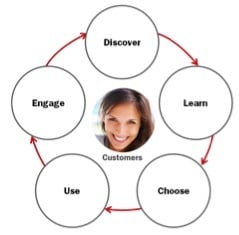For your customers and prospects
For your customers and prospects, your customer relationship lifecycle is the basis for their experiential “journey” with your brand–from awareness of your company or product to selection or purchase, satisfaction, and loyalty. It’s called a lifecycle because it depicts the life of your relationship with your customers. And since the goal of your lifecycle is to engage and deepen the relationship, it is circular in nature with the customer appropriately located in the center.
The better their experience as they progress through it the more customers will move from one stage to the next, driving increased engagement and loyalty. In each stage, you have the opportunity to understand and meet their needs, deepening the relationship along the way. Or, you might unwittingly erect barriers to progress along the way, causing customers to drop out of the relationship–most never to return.
Defined by a series of predictable stages, your lifecycle is a unique experiential "journey" from awareness of your company to, ideally, advocacy for it. Throughout the lifecycle, your brand, marketing, and service delivery touchpoints–digital and otherwise–define customer experience.
Attracting and keeping customers begins with understanding how well your brand and touchpoints work, or don't, at driving movement from one stage to the next. By understanding attitudes, perceptions, and influencers at each stage, you can see where the relationships between you and your customers can be improved.
 A multi-stage journey from discovery to engagement, with loyalty the goal.
A multi-stage journey from discovery to engagement, with loyalty the goal.
While every company has its own unique customer lifecycle, the core framework remains the same. This five-stage model is the basic framework for all lifecycles, though analysis of yours may identify four, six, or seven stages.
Regardless of your unique lifecycle, the early stages align closely with the traditional sales or marketing funnel, beginning with awareness or discovery. Once a customer has discovered your brand, they need to learn more about it. Does it fit their wants and needs? What alternatives exist? Assuming your customers make it this far, the next step is to choose your brand. This stage includes selection or purchase, and is followed by use.
Looked at through the sales funnel these steps conclude the acquisition process and–and for many companies–signal a decreased focus on customers. Realistically, this is where the hard work begins. Because the step following choose is use, and this is where most companies need to excel to boost repurchase and retention, and drive towards loyalty.
With the experience of using your product or service, customers get the feel of what the experience of interacting with you after the sale is really like. They’ll ask themselves questions like:
- Are you easy to use or work with?
- Do they enjoy interacting with you?
- Are you and your touchpoints (and the people, processes, and systems that deliver them) effectively meeting their wants and needs?
If they believe the answers to these questions are “yes,” you’ll be able to progress to the next stage of the lifecycle–engagement–driving a virtuous cycle of additional discovery, choice and use, boosting customer loyalty as a result.

